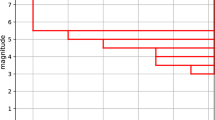Abstract
A Bayesian approach is used to analyze the seismic events with magnitudes at least 4.7 on Taiwan. Following the idea proposed by Ogata (1988,Journal of the American Statistical Association,83, 9–27), an epidemic model for the process of occurrence times given the observed magnitude values is considered, incorporated with gamma prior distributions for the parameters in the model, while the hyper-parameters of the prior are essentially determined by the seismic data in an earlier period. Bayesian inference is made on the conditional intensity function via Markov chain Monte Carlo method. The results yield acceptable accuracies in predicting large earthquake events within short time periods.
Similar content being viewed by others
References
Akaike, H. (1974). A new look at the statistical model identification,IEEE Transactions on Automatic Control,19, 716–723.
Berger, J. O. (1985).Statistical Decision Theory and Bayesian Analysis, Springer-Verlag, New York.
Betrò, B. and Ladelli, L. (1996). Point process analysis for Italian seismic activity,Applied Stochastic Models and Data Analysis,12, 75–105.
Daley, D. and Vere-Jones, D. (1988).An Introduction to the Theory of Point Processes, Springer-Verlag, New York.
Fan, T. H. and Lin, J. S. (2002). A Bayesian analysis for the seismic data in Hualien area,Journal of Chinese Statistical Association,40, 229–247.
Musmeci, F. and Vere-Jones, D. (1992). A space-time clustering model for historical earthquakes,Annals of the Institute of Statistical Mathematics,44, 1–11.
Ogata, Y. (1988). Statistical models for earthquake occurrences and residual analysis for point processes,Journal of the American Statistical Association,83, 9–27.
Ogata, Y. (1989). Statistical model for standard seismicity and detection of anomalies by residual analysis,Tectonophysics,169, 159–174.
Ogata, Y. (2002). Slip-size-dependent renewal processes and Bayesian inferences for uncertainties,Journal of Geophysical Research,107 (B11), 2268, doi: 10.1029/2001JB000668.
Ogata, Y. and Katsura, K. (1988). Likelihood analysis of spatial inhomogeneity for marked point patterns,Annals of the Institute of Statistical Mathematics,40, 29–39.
Peruggia, M. and Santner, T. (1996). Bayesian analysis of time evolution of earthquakes,Journal of the American Statistical Association,91, 1209–1218.
Rhoades, D. A., Van Dissen, R. J. and Dowrik, D. J. (1994). On the handling of uncertainties in estimating the hazard of rupture on a fault segment,Journal of Geophysical Research,99, 13701–13712.
Schwarz, G. (1978). Estimating the dimension of a model,The Annals of Statistics,6, 461–464.
Utsu, T. (1961). A statistical study on the occurrence of aftershocks,Geophysical Magazine,30, 521–605.
Author information
Authors and Affiliations
About this article
Cite this article
Fan, TH., Kuo, EN. A Bayesian analysis for the seismic data on Taiwan. Ann Inst Stat Math 56, 599–609 (2004). https://doi.org/10.1007/BF02506478
Received:
Revised:
Issue Date:
DOI: https://doi.org/10.1007/BF02506478




